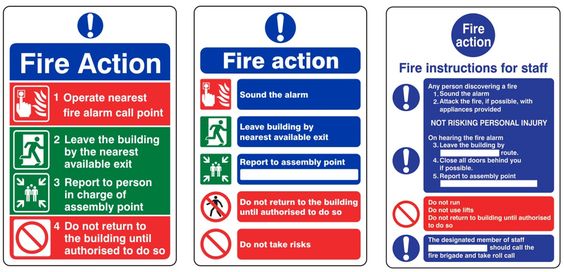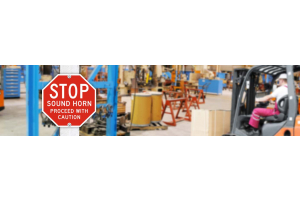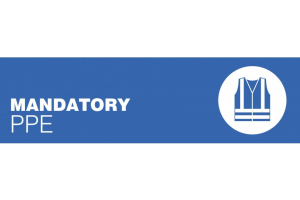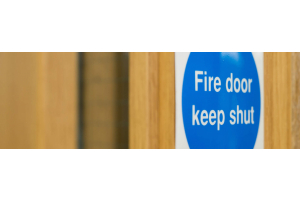
Detailed Guidance Regarding Fire Action Signage
Fire action signage is present in all workplaces and public buildings, in this article i will provide detailed information about fire action notice signs, why they are essential for all places of work both indoors and out how if the instructions are followed carefully could save lives. Building owners, landlords and employers who have ultimate control of a building must carry out a fire risk assessment of their building or workplace to discover any significant findings which may put others in danger or cause harm or injury to themselves or others, although fire action signs may seem trivial, the specific steps of actions taken may prevent themselves being harmed or injured in the event of a fire. Detailed below are the specific steps of action as described on signage designed for taking action in the event of a fire in workplaces and buildings, although all workplaces will vary in their processes of the steps according to the size and nature of the workplace procedures the principle of actions to takes remain the same.
Are fire action signs mandatory?: fire action signs are mandatory on two levels, firstly they are required by law to be displayed in and around all places of work, without signs to instruct people and occupants of the building what do do in the event of a fire could prove fatal in the event of a fire, as described above each workplace may have their own fire evacuation procedures in place but this needs to be recognised by everyone in and around the buildings including staff, visitors, contractors and where appropriate the general public, secondly fire action signs are mandatory in the sense they fall under the mandatory message types of signs, all fire action notice signs regardless of background colour, material or size features the mandatory pictogram symbol which is a white exclamation symbol displayed on a blue circular background which provides the meaning to others that the step-by-step actions on this sign must be understood, followed and carried out, just below the symbol is the message "FIRE ACTION" which conveys to everyone the actions to take in the event of a fire.
Any Person Discovering A Fire
Step 1 Sound The Alarm: It is vital for employers and building owners to mount and display fire action notice signs in not only clear and prominent positions but also mount them above, next to, near or adjacent to the device in which people would use to sound the fire alarm, all buildings and both workplaces indoors and outdoors may offer different ways and methods of raising the fire alarms, the more common types of fire alarm call points are the ones connected to a fire alarm panel but in outdoor locations such as building and construction sites the fire alarm raising method could be a klaxon, megaphone, rotary hand bell, an air horn or even someone shouting "FIRE" could be the way the alarm is raised, it is for this reason that anyone discovering a fire MUST raise the alarm but the sign must be near the method used to raise the alarm. At this point it is important to emphasise why raising the alarm is crucial first step, if the person discovering the fire (fire warden trained or not) attempts to tackle the fire themselves by using a fire extinguishers or a fire blanket for that matter they may be overwhelmed by flames and smoke trying to put out the fire, they may use the wrong type of fire extinguisher to extinguish the fire which could put themselves and others in greater danger or the fire might get out of control and start to rapidly spread throughout the building in turn putting everyone's lives at risk, it is for this reason that the person discovering a fire must sound the fire alarm first as this will (depending on the size of the workplace) put fire procedures instantly into place such as an evacuation process and the occupants can start to leave the building as drilled, there is no harm if the fire is small enough for a trained and competent person to try and tackle the fire using the correct type of fire extinguishers but only AFTER the fire alarm has been raised, by carrying out this method we can see that before the fire has a chance to start spreading we are already evacuating people and the fire and rescue services will be on their way.
Step 2 ...To call the fire brigade: This step is not present on all fire action signs as it features a blank space for you to write the names of the person responsible for calling the fire brigade, this type of fire action sign is suitable for large complex buildings such as factories, manufacturing plants, industrial premises, schools and hospitals as these types of premises will have zoned areas, these zoned areas may be completely separated from other parts of the building and have nominated, trained staff such as fire wardens and marshals who will call the fire brigade and in some premises there will be emergency telephones installed for this purpose. Small workplaces such as shops, cafe's and small offices can simply have someone from reception to call the fire brigade when the fire alarm is sounding but the reception must be manned at all times if there is a least 2 people including the receptionist in the building. It is vital that the fire brigade is called by someone nominated or not if they hear the fire alarm sounding, in smaller premises staff can ask each other if they have called the fire service but in larger buildings it is far better the fire service receive a number of emergency calls from the same building rather than everyone assuming someone else has called the emergency services.
Step 3 Attack the fire if possible using the appliances provided: This step is not present on all fire action notice signs, as detailed above in step 1 this should only be attempted as the 3rd step and only by trained, qualified and competent people who have received the relevant fire extinguisher, fire warden or fire marshal training, all fire start small unless it's an explosion so if the fire is small enough for example a computer or an IT server has caught fire the trained person will know and understand they can attempt to extinguish the fire by using a Co2 fire extinguisher which contains liquid co2 which turns into a gas when mixed with air or oxygen and can be used to tackle live electric fires such as the computer or IT server, the co2 gas is a clean, searching agent which will displace the oxygen around the fire and in turn putting the out, at this point the electricity supply to the computer of IT server must be cut of the source of fuel, if the fire re-ignites but no power is present a foam fire extinguisher can be used. This seems a long process but for trained people it may take 1-2 minutes but if the fire does get out of hand we now know the fire brigade is on the way.
On Hearing The Fire Alarm
Step 4 Leave the building: When the occupants of the building hear the fire alarm they must leave the building immediately, all workplaces and buildings differ in the way people leave the building, in larger sites with zones may have specific escape routes for the occupants to evacuate as the fire assembly points for each zone may depend on the fire exits they use, smaller premises might instruct people to use the nearest available exit by following the fire exit routes according to the fire exit signage with specific directional arrows. In large sites such as factories and manufacturing plants there are normally fire assembly points sited around the perimeter of the premises and each zone of the building will have designated assembly points according to the fire exits within the zone, this method ensures people are evacuated very quickly with only limited people at each assembly point which. provides an orderly evacuation which prevents crowds of people leaving the building to one point which may hamper the arrival of the emergency services.
Step 5 Close All Doors Behind You: This step may not be present on all fire action signs, in large commercial sites the the daily working practices may involve the use of specific chemicals, gases or other goods which have a flammable nature including combustible material such as paper and cardboard in the packaging areas so it is very important where these doors are open during normal working hours that they are closed if the fire alarm is sounded and an evacuation is in progress, this same applies to all other building including any doors on escape routes, if they don't close by themselves they will need to be closed behind you, this is very important as we want to restrict the spread of fire and smoke from spreading around the building which makes the job of the fire fighters much easier because hopefully the fire is contained in areas, zones or rooms, read more detailed information about fire door signage and it's importance. When the alarm is sounding it is possible that people are in the toilets, washrooms, rest rooms or canteens so it is just as important these doors are also closed behind you.
Step 6 Report To Assembly Point: You will find this step on all fire action signs, just as important as raising the fire alarm if you discover a fire making sure the occupants attend fire assembly points is crucial especially where the muster points are designated for specific zones or areas. Large buildings will have their fire assembly points conveying either letters or numbers for ease of identification by the evacuees, for example if the packing zone evacuated via fire exit number 42 the designated fire assembly point could be number 6 or latter E, this method in large sites helps ensure only a limited number of people are gathering around the assembly points which makes it much easier for managers or fire marshals to control and take a roll call of those accounted for. Small and medium sized buildings will have their own assembly point methods which might be for the occupants to assemble at the end of the car park or or immediately outside the gates.
Whichever method you use for accounting for the occupants when the building is being evacuated it is vital all personnel are aware, staff can be issued with a memo and confirm with management both in writing and verbally they understand where to go, visitors not accompanied by a member of staff must be told where they must attend, the same goes for contractors and where appropriate the general public. Regardless of the fire assembly point method used it is vital that the occupants are reminded of it's importance, for example, during an evacuation if one or two people decide to leave the premises but go for a walk or to their car instead of the fire assembly point for registration then there is a very serious problem to deal with, the missing people cannot be accounted for, therefore as far as the manager or fire marshal is concerned these people are unaccounted for and we assume still in the burning building, this information must be relayed to the fire and rescue service and now they have to be very careful and search for two missing people in the building who are actually in a safe place outside, so not attending the fire assembly point for the roll call could put others people lives at risk by trying to find someone who is not there.
Additional Fire Action Information
As we understand from the introduction all of the above are instructions which are mandatory in which everyone must follow to help keep themselves, others and even the emergency services safe, at the footer of the fire action signs they normally convey one or two prohibition messages, as we know the last action above is to report to the fire assembly points to be accounted for, and one of the prohibition messages is "Do not return to the building until authorised to do so", this is crucial as re-entering the building may put peoples lives at risk as the fire may not be extinguished and you can also become trapped by falling objects as well as fire and smoke. Another prohibition message is "Do not use lifts", this is vital where lifts are installed in buildings as the lift is liable to break down and people can become trapped between floors of the building which once again will put the fire and rescue services lives in danger.
Types Of Fire Action Notice Signs
There are numerous types of fire action notice signs for business owners to choose from, nite-glo fire action signage features being able to glow in the dark for up to 6 hours in the event of a power failure, xtra-glo fire action signage provides even more illumination than nite-glo signage and will glow very bright in darkness for up to 12 hours, fire action signs made from aluminium can be a great benefit for workplaces wanting to either mount fire action signs in outdoor areas such as courtyards and outdoors working areas or where employers want signs which will blend in with their interior decor to provide a luxury look and feel to their building, fire action signs are also made from acrylic material which is 6mm thick, glows in the dark and also offers a prestigious look and feel to compliment the interior decor, brass fire action signs also offer a luxury finish which complements interior decors and is the most popular choice for hotels and establishments. As you can see with such a diverse range of fire action signage there is many to choose from but ultimately they all offer valuable, detailed, step-by-step instructions of what to do in the event of a fire.




